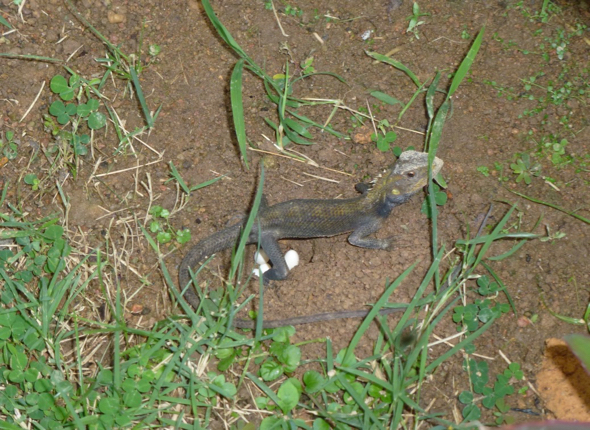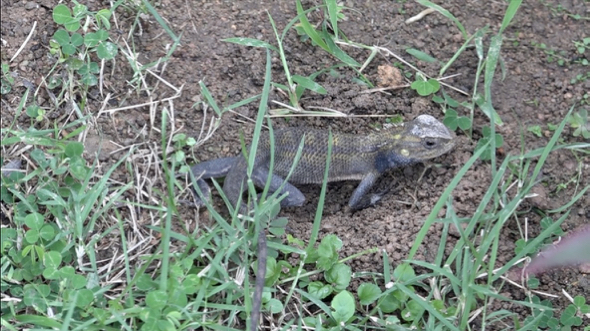Tinny G Unciano was sweeping the garden of fallen leaves when she came across a female Changeable Lizard (Calotes versicolor) laying eggs. The lizard apparently had dug a small hole in the ground and laid about half a dozen white eggs (below). By the time I managed to assemble my videocam, the lizard had completed laying her eggs. She was lying on the ground with her hindlimbs across the hole, the exact position she was in when she was laying her eggs. She remaining still for about 3-4 minutes.

Then, turning around, she directed her head downwards and began compacting the soil that was earlier scraped over the eggs. This she did by thrusting here head into the soil so that her snout did the compacting. Following this, she started scraping the surrounding soil, first with the claws of one forelimb, then with those of the other. After a short rest, she used her snout to compact the soil again. Turning around clockwise and anti-clockwise, she repeated scraping the soil, resting, compacting the soil and resting again for a total of 13 cycles until the hole was covered. The surface was meticulously flattened with her claws with compacting when necessary until there was no evidence that a hole had previously been dug (see video below).
Initially I was slightly more than a meter away before leaving the videocam to complete the documentation in my absence. It was then when she was levelling the surface that a pair was of inquisitive Javans Mynas (Acridotheres javanicus) approached her. The lizard responded by flashing her small orange throat flap and later raised her body as well as puffing her neck when one of the mynas came too close.

The entire exercise took about half an hour before the lizard scampered away

There, the eggs will remain, absorbing moisture and growing in size until they are ready to hatch in 8-9 weeks LINK. However, under laboratory conditions it takes 40-47 days LINK.
I sent the video to Kelvin KP Lim of the Lee Kong Chian Natural History Museum, National University of Singapore as I was unable to locate any mention of the female Changeable Lizard having a black blotch over each cheek and throat as well as having a small orange throat flap.
Kelvin Lim’s reply: “That is a Calotes versicolor alright. I’m not aware that the female assumes this colour pattern when she is laying eggs. I agree with you that she looks quite like a male with the blackish cheeks and orange throat. She also took a long time to bury the eggs and fuss over the site, apparently compacting the soil with her snout… I have not come across published descriptions of the egg depositing coloration but that doesn’t mean it doesn’t exist. I think your sighting is highly significant and ought to be properly documented.”
YC Wee & Kelvin KP Lim
Singapore
13th May 2018
Note:
The above account has now been published in the Lee Kong Chian Natural History Museum’s Singapore Biodiversity Records 2018: 70-71 – PDF.








